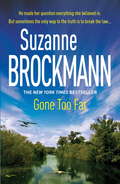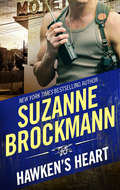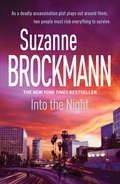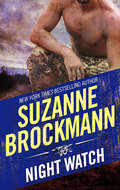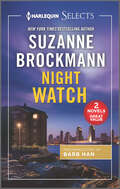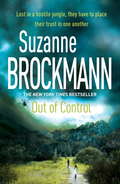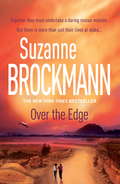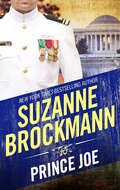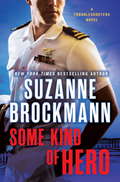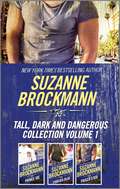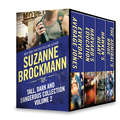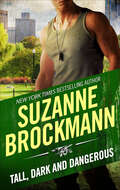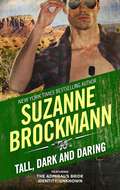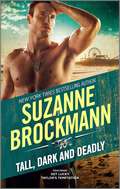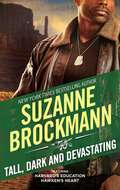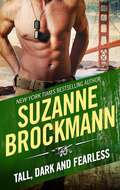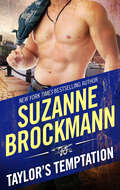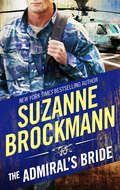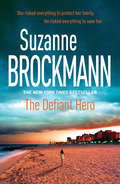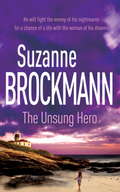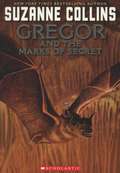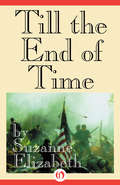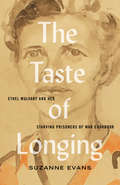- Table View
- List View
Gone Too Far: Troubleshooters 6 (Troubleshooters #6)
by Suzanne BrockmannTroubleshooters: They Never Let You Down. The sixth addictive romantic suspense novel in New York Times bestselling author Suzanne Brockmann's Troubleshooters series, filled with thrilling adventure, excitement and passion. In GONE TOO FAR, ex-lovers Lieutenant Sam Starrett and FBI agent Alyssa Locke find that sometimes the only way to the truth is to break the law...Whilst Lieutenant Sam Starrett's career as a Navy SEAL has gone from strength to strength, his private life has turned into a mess. Waiting for his divorce papers was always going to be tough but Sam's life turns into a nightmare when he arrives at his ex-wife's home for a visit with his young daughter to find a woman lying brutally murdered and his daughter missing. FBI agent Alyssa Locke is dismayed to find herself assigned to Sam's case. She and her former lover have a complex history and their intense attraction has never gone away. But with Sam the main suspect in a murder investigation, Alyssa is faced with an impossible dilemma: arrest a man she believes in her heart to be innocent, or risk her career to help save him. With passion simmering between them, Alyssa and Sam must go on the run to discover the truth and find Sam's daughter, but they have no idea how deadly this situation is about to become...
Harvard's Education
by Suzanne BrockmannIt was an experiment. . . but no one could have predicted the results. For eight weeks FInCOM agent P. J. Richards is being given access to the absolutely-no-women-allowed world of the U. S. Navy SEALs, and she isn't about to let anyone tell her she can't hack it. P. J. can't afford to be distracted by anything. . . or anyone. And that includes Senior Chief "Harvard" Becker. Harvard believes that there is no room for women in a combat zone. It's too dangerous, too tough. . . and with P. J. involved, too distracting. He might respect her sharp intellect and her shooting abilities, but he still doesn't want the responsibility of making sure she stays alive. But P. J. isn't a woman who backs down easily, and to her mind, Harvard has a lot to learn. She just doesn't expect him to be so eager to instruct her on other subjects. . . like trust, desire and maybe even love.
Hawken's Heart
by Suzanne BrockmannNew York Times and USA TODAY bestselling author Suzanne Brockmann has thrilled audiences with her Tall, Dark and Dangerous series. Experience it here with a hero who must face the most daring adventure of all--falling in love. They're on the run from the law, but they can't escape each other... Navy SEAL Crash Hawken awakens in a Washington, DC, hospital to learn that he is the prime suspect in the assassination attempt on a commanding officer. Charged with treason, conspiracy and murder, he is alone--except for Nell Burns. Nell and Crash have a history, both as friends and as lovers. And she knows he could not have committed these crimes. Soon they are on the run, determined to uncover what really happened the night of the attempted assassination&--but first they have to survive another day.
Into the Night: Troubleshooters 5 (Troubleshooters #5)
by Suzanne BrockmannTroubleshooters: They Never Let You Down. The fifth addictive romantic suspense novel in New York Times bestselling author Suzanne Brockmann's Troubleshooters series, filled with thrilling adventure, excitement and passion. In INTO THE NIGHT, as a deadly assassination plot plays out around them, White House staffer Joan DaCosta and Lieutenant Mike Muldoon must risk everything to survive.When White House staffer Joan DaCosta is assigned to work with Navy SEAL Lieutenant Mike Muldoon on a presidential visit to a Californian naval base, she is reluctant to admit quite how drawn she is to the handsome young officer. For a woman who has always prided herself on being 'one of the guys' in the mostly male-dominated world of politics, it's stunning to her how quickly Mike breaks through her defences. Mike may be younger than Joan in years, but his experience in the field has made him strong, decisive and fearless - he's more than a match for Joan. But as their attraction grows, so does a terrible danger: terrorists are plotting to attack the president. Now, Joan and Mike must risk their lives and everything they hold dear, including their hearts, if they are to save their commander-in-chief from the disaster that awaits him...
Night Watch
by Suzanne BrockmannNew York Times and USA TODAY bestselling author Suzanne Brockmann has thrilled audiences with her Tall, Dark and Dangerous series. Experience it here with a hero who must face the most daring adventure of all--falling in love. How can he choose between an old flame and a new spark? When US Navy SEAL Chief Wes Skelly is sent to LA on assignment, he reluctantly agrees to go on a blind date with Brittany Evans, the sister-in-law of a fellow SEAL. After all, he's been secretly pining for a very unavailable woman and he needs to get over her. So what does he have to lose? Plenty, as it turns out. Because suddenly the woman he'd thought he could never have is single. However, so is Brittany--and she's in danger because of him. He knows he can keep her safe... Book 11 of Tall, Dark & Dangerous series. Originally published in 2003.
Night Watch (Tall, Dark And Dangerous Ser. #11)
by Suzanne BrockmannThe most daring adventure of allNight Watch by New York Times Bestselling Author Suzanne Brockmann US navy SEAL chief Wes Skelly has been secretly pining for a very unavailable woman for years. So when he agrees to go on a blind date with Brittany Evans, he&’s not really expecting romance. But the single mom is kind, caring and beautiful. And when Brittany is suddenly in danger, he knows he must keep her safe. Because now he has everything to lose… FREE BONUS STORY INCLUDED IN THIS VOLUME!Hard Target by USA TODAY Bestselling Author Barb Han Border Patrol agent Reed Campbell is shocked to find Emily Baker hiding out in a crate of guns smuggled into Texas. She claims she was kidnapped and held hostage by Mexico&’s most elusive drug lord, a man Reed&’s desperate to bring down. Determined to protect her, he takes her on the run, risking his life. Keeping Emily alive is a problem. Keeping his heart safe is nearly impossible.New York Times Bestselling Author Suzanne Brockmann
Out of Control: Troubleshooters 4 (Troubleshooters #4)
by Suzanne BrockmannTroubleshooters: They Never Let You Down. The fourth addictive romantic suspense novel in New York Times bestselling author Suzanne Brockmann's Troubleshooters series, filled with thrilling adventure, excitement and passion. In OUT OF CONTROL, Savannah von Hopf and Navy Seal Ken 'WildCard' Karmody are lost in a hostile jungle with no choice but to place their trust in one another...When Savannah von Hopf's uncle is kidnapped in Indonesia there is only one man she can turn to help: Navy Seal Ken 'WildCard' Karmody. But before she has the chance to ask for his help, she finds herself caught up with him in a passion she never thought possible. WildCard's soft spot has always been beautiful women and he is furious on learning Savannah's deception. But his honour won't allow Savannah to undertake her desperate mission alone. Then the ransom drop goes horribly wrong and WildCard and Savannah find themselves trapped in the hostile, forsaken jungle of Indonesia, hunted by lethal enemies on all sides. As they risk their lives to escape a nightmare spinning out of control can WildCard guard his heart against the woman he will go to any lengths to protect?
Over the Edge: Troubleshooters 3 (Troubleshooters #3)
by Suzanne BrockmannTroubleshooters: They Never Let You Down. The third addictive romantic suspense novel in New York Times bestselling author Suzanne Brockmann's Troubleshooters series, filled with thrilling adventure, excitement and passion. In OVER THE EDGE, Lieutenant Teri Howe and Senior Chief Stan Wolchonok are made to undertake a daring rescue mission. But there is more than just their lives at stake...Lieutenant Teri Howe is one of the best helicopter pilots in the naval reserves. Strong and dedicated, her passion for flying is only rivalled by her attraction to Senior Chief Stan Wolchonok. And when a past mistake surfaces, jeopardizing everything Terri has worked for, she immediately turns to Stan for support. Stan doesn't hesitate to come to Terri's aid, even though he knows his personal code of honour - and perhaps his heart - will be at risk. But when a jet carrying an American senator's daughter is hijacked, Stan can no longer keep Terri at arm's length - he needs her flying skills to help him undertake a daring rescue mission. In the midst of danger, and as the boundaries between friends and lovers begin to blur, Terri and Stan realise that they are being pushed over the edge into a future that might be more than they ever dreamt of...
Prince Joe: Prince Joe Forever Blue Frisco's Kid (Tall, Dark and Dangerous #1)
by Suzanne BrockmannThe New York Times–bestselling author thrills fans with a series that starts with a military hero facing the most daring adventure of all—falling in love.It will be the biggest challenge of Veronica St. John’s career. She has two days to teach a rugged Navy SEAL to impersonate a European prince who has been targeted by terrorists. It’s a tough assignment, but Veronica is sure she’s up to the task—until she actually meets Joe.Despite his physical resemblance to the handsome prince, Lieutenant Joe Catalanotto is nothing like the stuffy aristocrat. Everything about the combat-hardened Navy SEAL—from the arrogant gleam in his eyes and streetwise attitude to the New York accent—says regular guy, not royalty. One conversation and Veronica knows nothing could turn this military man into an aristocrat. Joe, on the other hand, is confident he’s got what it takes to complete his duty.But neither of them expects their assignment to include falling in love . . . “Not only is the suspense nail-bitingly intense, the blistering passion and emotional sensitivity make this a love story you’ll put in your treasure chest.” —Romantic Times
Some Kind of Hero: A Troubleshooters Novel (Troubleshooters #19)
by Suzanne BrockmannThe Troubleshooters return in the latest thriller from New York Times bestselling author Suzanne Brockmann! Some Kind of Hero showcases Brockmann’s signature white-knuckle suspense, romantic twists, and sexy Navy SEALs. Navy men don’t come tougher than Lieutenant Peter Greene. Every day he whips hotshot SEAL wannabes into elite fighters. So why can’t he handle one fifteen-year-old girl? His ex’s death left him a single dad overnight, and very unprepared. Though he can’t relate to an angsty teen, he can at least keep Maddie safe—until the day she disappears. Though Pete’s lacking in fatherly intuition, his instinct for detecting danger is razor sharp. Maddie’s in trouble. Now he needs the Troubleshooters team at his back, along with an unconventional ally. Romance writer Shayla Whitman never expected to be drawn into a real-world thriller—or to meet a hero who makes her pulse pound. Action on the page is one thing. Actually living it is another story. Shay’s not as bold as her heroines, but she’s a mother. She sees the panic in her new neighbor’s usually fearless blue eyes—and knows there’s no greater terror for a parent than having a child at risk. It’s an ordeal Shay won’t let Pete face alone. She’s no highly trained operative, but she’s smart, resourceful, and knows what makes teenagers tick. Still, working alongside Pete has its own perils—like letting the heat between them rise out of control. Intimate emotions could mean dangerous, even deadly, consequences for their mission. No matter what, they must be on top of their game, and playing for keeps . . . or else Pete’s daughter may be gone for good.Advance praise for Some Kind of Hero“Nobody mixes suspenseful adventure and heart-melting romance like Suzanne Brockmann.”—USA Today bestselling author Sarina Bowen “Nobody does it better! Some Kind of Hero is Suzanne Brockmann at the top of her game, with a story full of heartstopping action and genuine, funny, heartfelt emotion.”—New York Times bestselling author Virginia Kantra “In classic Brockmann style, Some Kind of Hero does not shy away from the controversies of our times. Instead, it faces them head on, delivering a thought-provoking, high-octane love story with a hero and heroine one can’t help but root for. Prepare to be blown away.”—USA Today bestselling author Farrah Rochon “Delicious sexual tension and a fast-paced plot made me want Some Kind of Hero to last way past the final page.”—USA Today bestselling author Megan Erickson “Brockmann is a master at romantic suspense. Sexy, smart, and completely original, Some Kind of Hero is not to be missed.”—HelenKay Dimon, award-winning author of the Tough Love series “The writer in me can’t believe that Brockmann keeps getting better with every book. The reader in me loves it!”—M. L. Buchman, author of The Night Stalkers series and Delta Force series“Fast-paced suspense and a to-die-for hero! This book will be a new favorite for Brockmann fans.”—New York Times bestselling author Elle Kennedy “A thought-provoking, deeply satisfying romance from a master of the genre.”—Kirkus Reviews (starred review)
Tall, Dark and Dangerous Collection Volume 1: Prince Joe\Forever Blue\Frisco's Kid (Tall, Dark and Dangerous)
by Suzanne BrockmannTall, Dark and Dangerous Collection Volume 1 by Suzanne Brockmann released on Oct 16, 2017 is available now for purchase.
Tall, Dark and Dangerous Collection Volume 2: Everyday, Average Jones\Harvard's Education\It Came upon a Midnight Clear\The Admiral's Bride
by Suzanne BrockmannFall back in love with New York Times bestselling author Suzanne Brockmann's Tall, Dark and Dangerous series, originally published in 1997. EVERYDAY, AVERAGE JONES: All her life Melody Evans has wanted to marry a plain, average man who doesn't take risks. But when the foreign embassy is taken over by terrorists and she's rescued by a daring Navy SEAL, Melody discovers that Harlan “Cowboy” Jones is anything but. HARVARD'S EDUCATION: Senior Chief “Harvard” Becker believes that there is no room for women in a combat zone. It's too dangerous, too tough…and with P.J. involved, too distracting. But P.J. isn't a woman who backs down easily, and to her, Harvard has a lot to learn. She just doesn't expect him to be so eager to instruct her on other subjects…like trust, desire and maybe even love. IT CAME UPON A MIDNIGHT CLEAR: As Christmastime settles quietly over the countryside, Navy SEAL William “Crash” Hawken is faced with a deadly conspiracy. And he has only one person to turn to—the caring, passionate Nell Burns. Crash begins to see all they could have together, what the future might hold. If only he could be assured that they had one… THE ADMIRAL'S BRIDE: When a lethal nerve agent is stolen from a military testing lab, Admiral Jake Robinson must recover the chemicals—by any means necessary. With Dr. Zoe Lange at his side, he must infiltrate the compound where religious fanatics have stored the deadly toxin. But Jake fears his instant attraction to Zoe might compromise the mission… Everyday, Average Jones, Harvard's Education, and It Came Upon a Midnight Clear originally published in 1998. The Admiral's Bride originally published in 1999.
Tall, Dark and Dangerous Collection Volume 3
by Suzanne BrockmannFrom New York Times bestselling author Suzanne Brockmann, four novels in the fan-favorite Tall, Dark and Dangerous series, collected here! IDENTITY: UNKNOWN: Navy SEAL Mitchell Shaw wakes up one morning with idea who he is. The items hidden in his possession are no help: an address and a .22 caliber sidearm. But the address leads him to the Lazy 8 Ranch—and its beautiful manager, Becca Keyes, who makes him believe he might have a future, even if he's not sure about his past. GET LUCKY: Navy SEAL Lucky O'Donlon is the original love-‘em-and-leave-’em guy, used to women swooning at his feet. So how can it be that the frustratingly attractive journalist Sydney Jameson has nothing to offer him but one very cold shoulder? TAYLOR'S TEMPTATION: When it came to protecting the innocent, Bobby Taylor is your guy. Except when his best friend asks him to keep an eye on his little sister. Gorgeous Colleen Skelly doesn't look like anyone's kid sister, and he wants to keep more than just his eye on her…. NIGHT WATCH: When U.S. Navy SEAL Chief Wes Skelly is sent to L.A. on assignment, he agrees to go on a blind date with beautiful single mother Brittany Evans, sister-in-law of a fellow SEAL. After all, he's been secretly in love for years, albeit with an unavailable woman. So what does he have to lose? Plenty, it turns out. Because suddenly, the woman he thought he could never have is available. However, so is Brittany—and not only that, she's in danger. Identity: Unknown originally published in 2000. Get Lucky originally published in 2000. Taylor's Temptation originally published in 2001. Night Watch originally published in 2003.
Tall, Dark and Dangerous: Tall, Dark And Fearless Tall, Dark And Devastating (Tall, Dark And Dangerous Ser. #1)
by Suzanne BrockmannFrom a New York Times–bestselling author, two classic novels about Navy SEALS who face the most daring adventure of all—falling in love.Prince JoeJoe Catalanotto is part of the military’s elite, and trained to succeed in the most dangerous situations. He also bears an uncanny resemblance to Prince Tedric. Media consultant Veronica St. John has been hired to teach the rugged Navy SEAL to impersonate the European prince who has been targeted by terrorists. Two days isn’t a lot of time to get the job done . . . but it’s just enough time to fall in love.Forever BlueWhen Navy SEAL Blue McCoy left the small town of Hatboro Creek, South Carolina, he never looked back. But when he comes home for his brother’s wedding all hell breaks loose. Police officer Lucy Tait has fantasized about Blue McCoy since high school . . . and nothing about him has changed, except Blue’s been charged with murder. As the investigation heats up, so does their relationship. Now they’re working to save Blue’s future—before they lose their hearts.Praise for Prince Joe“Not only is the suspense nail-bitingly intense, the blistering passion and emotional sensitivity make this a love story you’ll put in your treasure chest.” —Romantic TimesPraise for Forever Blue“Brilliant sexual chemistry, laugh-out-loud humor, riveting action, and flawlessly rendered characters.” —Library Journal (starred review)“Jam-packed with adrenaline-fueled action and sizzling sexual tension.” —Booklist (starred review)
Tall, Dark and Daring (Tall, Dark And Dangerous Ser. #8)
by Suzanne BrockmannExperience two classic tales of heroes facing danger and falling in love from New York Times and USA Today bestselling author Suzanne Brockmann’s Tall, Dark and Daring series — collected here in one volume!The Admiral’s BrideWhen six canisters of a lethal nerve agent are stolen from a military testing lab, Admiral Jake Robinson must recover the chemicals—by any means necessary. With Dr. Zoe Lange at his side he defies convention and decides to infiltrate the compound where religious fanatics have stored the deadly toxin. But Jake fears his instant attraction to Zoe might compromise the mission.Originally published in 2006Identity: UnknownNavy SEAL Mitchell Shaw woke up one morning with no clue as to who he was. The items hidden in his possession were no help: an address and a .22 caliber sidearm. But the address led him to the Lazy 8 Ranch—and its beautiful manager, Becca Keyes, who made him believe he might have a future. Even if he wasn’t sure about his past.Originally published in 2007
Tall, Dark and Deadly: "sexy, Suspenseful And Irresistible" (Tall, Dark And Dangerous Ser. #11)
by Suzanne BrockmannExperience two classic tales of heroes who face the most daring adventure of all—falling in love—from New York Times and USA TODAY bestselling author Suzanne Brockmann.Get LuckyThere’s only one woman who won’t play his game…Navy SEAL Lucky O’Donlon was the original love-’em-and-leave-’em guy used to women swooning at his feet. So how could it be that the frustratingly attractive journalist Sydney Jameson had nothing to offer him but one very cold shoulder? Well, two could play that game. But first things first—he and Sydney had a job to do. They had to get their man. Then there would be time enough for him to get his woman…Originally published in 2000Taylor’s TemptationCan he protect a woman he can’t resist?When it came to protecting the innocent, Bobby Taylor was your guy. Except when his best friend asked him to keep an eye on his little sister. Gorgeous Colleen Skelly didn’t look like anyone’s kid sister and he wanted to keep more than just his eye on her…After years of trying to get Navy SEAL Bobby Taylor to notice her, Colleen had finally succeeded. Bobby was hers, if only for a few days. And she was determined to prove she was a grown woman—and that he was all she would ever need in a man…Originally published in 2001
Tall, Dark and Devastating: "sexy, Suspenseful And Irresistible." (Tall, Dark and Dangerous #5)
by Suzanne BrockmannExperience two classic tales of heroes facing the most daring adventure of all—falling in love—from New York Times and USA Today bestselling author Suzanne Brockmann’s Tall, Dark and Dangerous series—collected here in one volume!Harvard’s EducationSenior Chief “Harvard” Becker believes that there is no room for women in a combat zone. It’s too dangerous, too tough…and with P.J. involved, too distracting. He might respect her sharp intellect and her shooting abilities, but he still doesn’t want the responsibility of making sure she stays alive. But P.J. isn’t a woman who backs down easily, and to her mind, Harvard has a lot to learn. She just doesn’t expect him to be so eager to instruct her on other subjects…like trust, desire and maybe even love.Originally published in 2004Hawken’s HeartNavy SEAL Crash Hawken awakens in a Washington, D.C., hospital to learn that he is the prime suspect in the assassination attempt on a commanding officer. Charged with treason, conspiracy and murder, he is alone—except for Nell Burns. Nell and Crash have a history—as friends, as lovers. And she knows he could not have committed these crimes. Soon they are on the run, determined to uncover what really happened the night of the attempted assassination. But first they have to survive another day.Originally published in 2005
Tall, Dark and Fearless: Frisco's Kid Everyday, Average Jones (Tall, Dark and Dangerous #3)
by Suzanne BrockmannRead these two daring classic tales of fearless men who will go any length to protect those they love…FRISCO’S KIDBeing a Navy SEAL is more than a career to Alan “Frisco” Francisco—it is his whole world. So when a bullet wound threatens his future in the Navy, he is determined to achieve a full recovery. But the unexpected appearance of his abandoned niece leaves Frisco with little time for anything but dealing with the five-year-old girl. His lovely neighbor Mia Summerton is determined to help him. She can’t mend his wounded body, but can she heal his heart?EVERYDAY, AVERAGE JONESMelody Evans just wants to marry an ordinary, average man who doesn’t take risks. But when the foreign embassy is taken over by terrorists and she’s rescued by a daring Navy SEAL, Melody blames the extreme circumstances for their ensuing passion. When it comes to ordinary, Harlan “Cowboy” Jones is anything but, and their encounter leaves Melody with a little more than just memories….Previously published.
Taylor's Temptation (Tall, Dark and Dangerous #10)
by Suzanne BrockmannA Navy SEAL struggles to resist his attraction to his best friend’s younger sister in this romantic suspense from a New York Times–bestselling author .Protecting the innocent is Navy SEAL Bobby Taylor’s passion. That’s why his best friend asked him to look out for his little sister, Colleen. Except that Colleen’s all grown up now, which has Bobby wanting to do so much more than keep her safe . . .
The Admiral's Bride
by Suzanne BrockmannNew York Times and USA TODAY bestselling author Suzanne Brockmann has thrilled audiences with her Tall, Dark and Dangerous series. Experience it here with a hero who must face the most daring adventure of all--falling in love. Now everything is on the line... When six canisters of a lethal nerve agent are stolen from a military testing lab, it's up to Admiral Jake Robinson to infiltrate the compound where religious fanatics have stored the deadly toxin. His partner--posing as his wife--is Dr. Zoe Lange, a biological warfare specialist and an expert in espionage. And though their marriage may be a hoax, Jake's growing feelings for Zoe are anything but make-believe. With each hour he's in Zoe's company the stakes get higher, and the situation within the compound is escalating...
The Defiant Hero: Troubleshooters 2 (Troubleshooters #2)
by Suzanne BrockmannTroubleshooters: They Never Let You Down. The second addictive romantic suspense novel in New York Times bestselling author Suzanne Brockmann's Troubleshooters series, filled with thrilling adventure, excitement and passion. In THE DEFIANT HERO, when Meg Moore risks everything to protect her family, Lieutenant John Nilsson finds he is willing to risk everything to save her.'The United States refuses to negotiate with terrorists'. Meg Moore remembered the warning from her job as a translator in a European embassy. Those same words will spell out a death sentence for her daughter and grandmother who have been kidnapped by a lethal group called the Extremists. Meg will do anything to meet their unspeakable demands; anything - even kill - to save her child. When Navy SEAL Lieutenant John Nilsson is summoned to Washington, D.C., by the FBI, to help negotiate a hostage situation, the last person he expects to see holding a foreign ambassador at gunpoint is Meg. He hasn't seen her in years, but he's never forgotten her. John could lose his career if he helps her escape. She will lose her life if he doesn't...
The Unsung Hero: Troubleshooters 1 (Troubleshooters #1)
by Suzanne BrockmannTroubleshooters: They Never Let You Down. The first addictive romantic suspense novel in New York Times bestselling author Suzanne Brockmann's Troubleshooters series, filled with thrilling adventure, excitement and passion. In THE UNSUNG HERO, Lieutenant Tom Paoletti faces a fight with the enemy of his nightmares if he is to have a chance of a life with the woman of his dreams, Kelly Ashton.After a near-fatal head injury, Navy SEAL Lieutenant Tom Paoletti is ordered to take a leave of absence from his team. Although it's the last thing he wants, Tom decides to make the best of a visit home to New England - and a chance to reconnect with childhood sweetheart Kelly Ashton. Kelly, now a doctor, has returned home to lick her wounds following a failed marriage but she has never forgotten Tom, the once infamous bad boy of the town. When Tom catches a terrifying glimpse of an international terrorist in their hometown, and the Navy dismisses the danger as injury-induced imaginings, Kelly is the one person who never doubts him. Creating his own makeshift counterterrorist team from his most loyal officers and the town's residents, Tom knows they must save the day if he is to have one last chance for happiness with Kelly...
Gregor and the Marks of Secret (Underland Chronicles Book #4)
by Suzanne CollinsGregor is drawn even deeper into a brewing crisis. For generations rats have run the mice out of whatever lands they've claimed, but now the mice are disappearing and Gregor must find out why.
Till the End of Time
by Suzanne ElizabethTwentieth century test pilot Captain Scott Ramsey is unwillingly trapped in the middle of the Civil War. Disguised as a rebel pirate, his art of seduction and mastery of disguise soon earn him a scandalous reputation. For her first assignment as a Union spy, Rachel Ann Warren must ensure that a hefty fortune remains safely out of the mysterious pirate's hands. The lovely undercover agent instantly intrigues Captain Ramsey. She possesses a strength and cunning that he has never witnessed, even in the women from his own time. He is overcome by his desire to return to his secure life in the future, but he can't seem to get the vision of Rachel out of his mind. As their passion grows, so do the emotions of the war around them. Beneath the fire of angry bullets, the star-crossed lovers melt the barriers of loyalty and time.
The Taste of Longing: Ethel Mulvany and Her Starving Prisoners of War Cookbook
by Suzanne EvansHalf a world away from her home in Manitoulin Island, Ethel Mulvany is starving in Singapore’s infamous Changi Prison, along with hundreds of other women jailed there as POWs during the Second World War. They beat back pangs of hunger by playing decadent games of make-believe and writing down recipes filled with cream, raisins, chocolate, butter, cinnamon, ripe fruit – the unattainable ingredients of peacetime, of home, of memory. In this novelistic, immersive biography, Suzanne Evans presents a truly individual account of WWII through the eyes of Ethel – mercurial, enterprising, combative, stubborn, and wholly herself. The Taste of Longing follows Ethel through the fall of Singapore in 1942, the years of her internment, and beyond. As a prisoner, she devours dog biscuits and book spines, befriends spiders and smugglers, and endures torture and solitary confinement. As a free woman back in Canada, she fights to build a life for herself in the midst of trauma and burgeoning mental illness. Woven with vintage recipes and transcribed tape recordings, the story of Ethel and her fantastical POW Cookbook is a testament to the often-overlooked strength of women in wartime. It’s a story of the unbreakable power of imagination, generosity, and pure heart.
